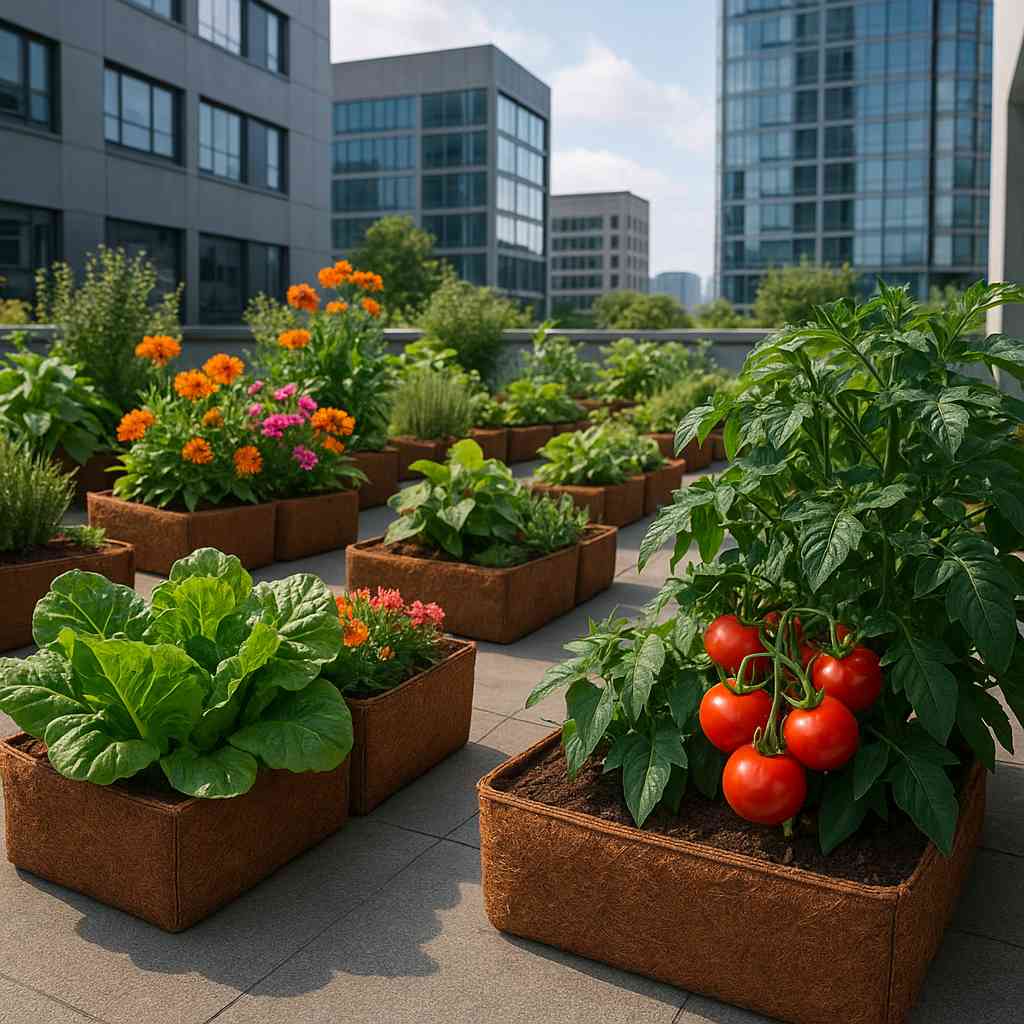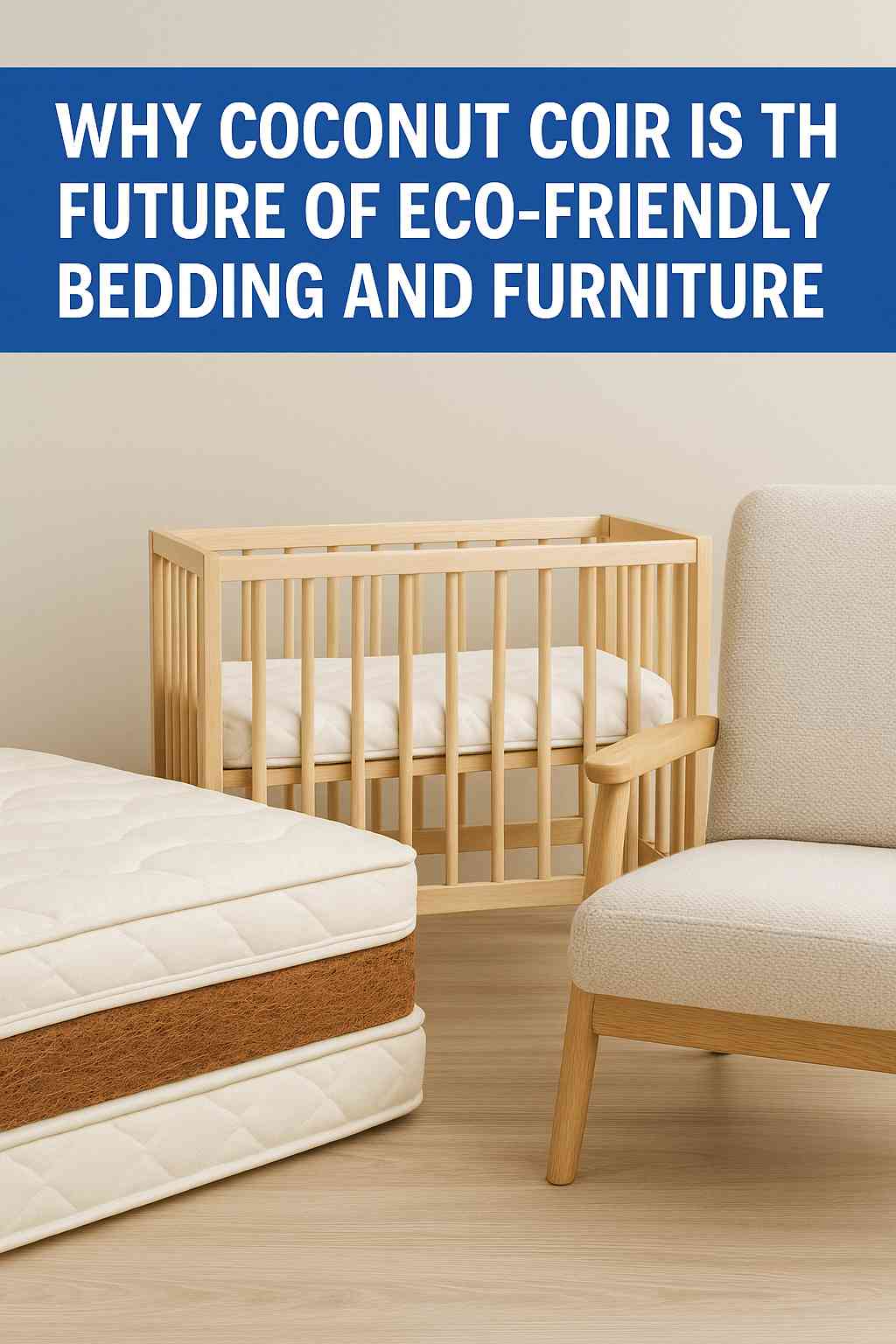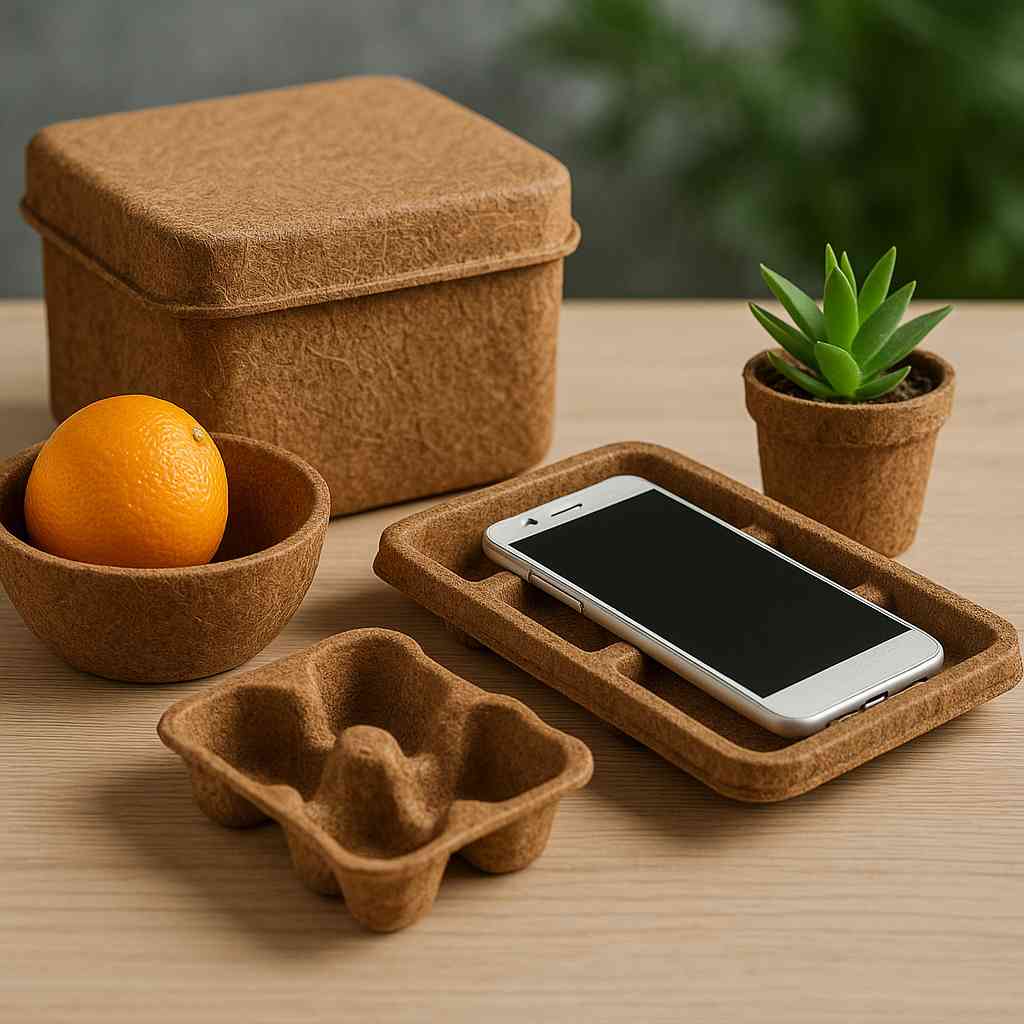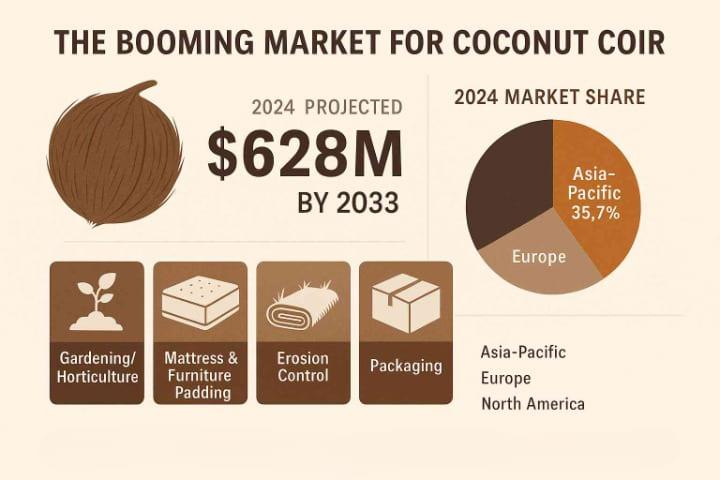Coconut Coir Market Report 2025: From Grow Bags to Eco-Packaging in the US, UK, and Europe
Gardening and Horticulture – Coconut Husk products Rapid Rise in Green Growing (2025)
In 2025, coconut coir is booming as a top choice for gardeners and professional growers alike. Its main form — coco peat or coir pith — is replacing peat moss in many countries thanks to its excellent water retention, aeration, and sustainable nature. This shift is especially visible in the United States, United Kingdom, and across Europe, where eco-friendly gardening is no longer a trend but a norm.
United States
In the US, cocopeat is becoming a staple in urban gardening, organic farming, and hydroponics. As more people grow plants at home or in greenhouses, they are choosing cocopeat over traditional soil and peat moss. Coconut coir is perfectly suited for cultivating a wide range of plants—from vegetables and flowering plants to high-value crops like cannabis. Leading suppliers such as Gro-Med, Plantonix, and Viagrow rely on imports from India and Sri Lanka to meet the rising demand for premium coir bricks and grow bags. These are then sold to commercial farms, nurseries, and even DIY gardeners via stores and online platforms.
Since the US doesn’t grow coconuts on a commercial scale, all coir is imported, mostly from India and Sri Lanka, the world’s biggest coir pith exporters or cocopeat suppliers. The import volumes are increasing year by year to meet the growing demand for soilless growing solutions.
United Kingdom
The UK is experiencing a major shift away from peat moss, driven by a government ban on peat for home gardeners from 2024 and professional growers by 2028. This makes coconut coir the top choice for replacement of peat moss.
Growers and garden centers are rapidly switching to coir-based mixes. Brands like Coco & Coir and Southern Trident are leading the market with peat-free compost products. The UK sources coconut coir blocks, grow bags, and pots mainly from South Asian countries, with some shipments arriving via European ports such as Rotterdam.
Despite earlier supply chain issues in 2021, the market has stabilized, and imports are on the rise. By 2025, coir will be the dominant component in UK potting soils, especially in organic and sustainable gardening products.
Continental Europe
Across Europe, especially in countries like Netherlands, Germany, and Spain, coir is widely used in commercial greenhouses. Growers love it for hydroponics and soil conditioning. The Netherlands leads the pack with big players like Dutch Plantin and Van der Knaap, who produce and export coconut husk products worldwide.
European demand is growing at around 15% per year, with the transition to peat-free growing media being a major driver. New EU regulations promoting organic farming and sustainability are also boosting coir use.
Europe mainly imports coconut husk products from India, Sri Lanka, and Vietnam, and re-exports it across the continent. Cocopeat blocks, grow bags, coir discs, and seedling plugs are all popular formats here.
Summary for Gardening & Horticulture:
- US: Strong growth in cocopeat for hydroponics and home gardening.
- UK: Peat bans are making coir the go-to growing medium.
Europe: Greenhouse-heavy markets are embracing coir fast, with Dutch companies leading global supply.

Why Coconut Coir Is the Future of Eco-Friendly Bedding and Furniture
Why Manufacturers and Retailers Are Turning to Coconut Coir for Eco-Focused Interiors
Coconut coir isn’t just for gardening — it’s also making waves in the mattress and furniture industries. Known for being breathable, firm, and chemical-free, rubberized coir (coir mixed with natural latex) is becoming a popular choice for eco-conscious customers in the US, UK, and Europe.
Though still a niche segment, coir padding is gaining steady traction due to the rising demand for natural, non-toxic, and sustainable bedding materials. Especially in premium mattresses and baby products, coir is winning hearts for offering firm support and good ventilation.
United States – Small But Growing Niche in Natural Mattresses
1. Usage Trends
- In the United States, most mattresses are still built using synthetic materials like foam..
- But there’s a fast-growing niche segment focused on green, organic, and chemical-free beds.
- Coir is mainly used as a support layer, especially in high-end mattresses that combine latex, cotton, wool, and coir.
2. Who’s Using It?
- Popular eco-mattress brands like Avocado Green Mattress use coir in many products.
- Their baby and toddler mattresses often have a coir core for safe, firm support.
- Adult versions feature a layer of coir mixed with latex to create a naturally cooling and breathable base.
3. Supply Chain
- The US does not produce coir fiber locally, so manufacturers import it from India and Sri Lanka.
- These imports typically arrive as ready-made coir sheets or rubberized coir mats, which are then assembled into final mattress products.
4. Market Growth
- The coir mattress segment is still small in the US but growing fast, especially as more consumers seek alternatives to polyurethane foam.
- Coir also appears in some sustainable furniture designs, though that’s a very small segment currently.
United Kingdom – Trusted Choice for Natural Baby Mattresses
1. Usage Trends
- The UK has a longer history of using coir in natural and organic mattresses, particularly for infants and toddlers.
- Coir is often combined with wool and cotton in crib mattresses, where firm support is essential for baby safety.
2. Leading Brands
- Devon-based Naturalmat was among the first companies to introduce coconut coir into mattress design. They’ve been crafting handmade mattresses with organic coir for decades.
- Other brands like The Little Green Sheep also use coconut coir mixed with latex in their baby and children’s products.
3. Furniture Use
- Some eco-furniture makers in the UK use coir as a natural filler for cushions or padding, especially in traditional or high-end furniture.
4. Supply and Import
- The UK doesn’t grow coconuts, so it imports coir from India, Shri lanka or through European suppliers like Enkev UK, a company that specializes in natural fiber padding.
- These fibers are often processed or shaped abroad and then assembled locally into mattresses or furniture pads.
Continental Europe – Eco-Luxury Segment Growing Steadily
1. Adoption in Premium Markets
- In Europe, coir is mostly used in the eco-luxury segment.
- Countries like Germany, the Netherlands, and Scandinavia have seen growing interest in organic, toxin-free bedding.
2. Top Brands & Innovators
- Coco-Mat (Greece) uses multiple layers of coconut fiber in their luxury beds — and has a presence across Europe.
- Van der Knaap Group (Netherlands) and Enkev (Netherlands/UK) manufacture and supply rubberized coir pads to European mattress brands.
3. Applications Beyond Mattresses
- Some sustainable furniture companies in Germany and Poland use coir in chair cushions, sofas, and pet beds.
- Coir also finds niche use in automotive seats and eco-upholstery, though this is still experimental.
4. Imports & Local Processing
- Most of the coir fiber is imported from India and Sri Lanka, but European companies process, bond, or shape it into usable mats and boards.
- These are then sold to mattress and furniture makers across the continent.
United States – Small But Growing Niche in Natural Mattresses
1. Usage Trends
- In the United States, most mattresses are still built using synthetic materials like foam..
- But there’s a fast-growing niche segment focused on green, organic, and chemical-free beds.
- Coir is mainly used as a support layer, especially in high-end mattresses that combine latex, cotton, wool, and coir.
2. Who’s Using It?
- Popular eco-mattress brands like Avocado Green Mattress use coir in many products.
- Their baby and toddler mattresses often have a coir core for safe, firm support.
- Adult versions feature a layer of coir mixed with latex to create a naturally cooling and breathable base.
3. Supply Chain
- The US does not produce coir fiber locally, so manufacturers import it from India and Sri Lanka.
- These imports typically arrive as ready-made coir sheets or rubberized coir mats, which are then assembled into final mattress products.
4. Market Growth
- The coir mattress segment is still small in the US but growing fast, especially as more consumers seek alternatives to polyurethane foam.
- Coir also appears in some sustainable furniture designs, though that’s a very small segment currently.
Summary for Mattress & Furniture Padding:
|
Region |
Usage |
Leading Brands |
Import Sources |
Notes |
|
US |
Natural mattresses (adult & baby) |
Avocado, Happsy |
India, Sri Lanka |
Niche market, growing |
|
UK |
Baby & eco-mattresses |
Naturalmat, The Little Green Sheep |
Sri Lanka, Enkev |
Strong interest in natural products |
|
Europe |
Premium organic beds & furniture |
Coco-Mat, Enkev, Van der Knaap |
India, Sri Lanka, Netherlands |
Innovative, slow but steady rise |

Erosion Control – Coconut Coir in Nature’s Defense System (2025)
Coconut Coir’s Role in Modern Erosion Control
Erosion is a big problem — whether it’s on riverbanks, slopes, or construction sites. To tackle it, many countries are turning to eco-friendly solutions, and coconut coir has become one of the top choices.
In the form of coir mats, blankets, rolls, and logs, this natural fiber helps stabilize soil, prevent erosion, and support vegetation growth. The best part? It naturally decomposes over time without leaving any harmful impact on the environment. In 2025, the US, UK, and Europe are seeing steady growth in demand for coir-based erosion control products.
United States – Going Green in Infrastructure Projects
1. Where It’s Used
- Coir is used in highway slopes, riverbanks, wetlands, and construction zones to prevent soil erosion and help new plants grow.
- It’s especially preferred in projects where plastic-based geotextiles are banned or discouraged due to pollution risks.
2. What Makes Coir Ideal?
- It’s strong, natural, and biodegradable.
- Coir logs and mats anchor the soil effectively, creating a stable base that helps native vegetation establish and thrive.
- After a few years, the coir decomposes naturally, leaving behind stable land and greenery.
3. Top Companies
- Based in Georgia, RoLanka International stands out as a leading provider of coconut coir products for erosion control across North America.
- East Coast Erosion Control manufactures coir logs by importing raw coir fiber and assembling the logs in the US.
- Other well-known names include Hanes Geo Components, Western Green, and GEI Works.
4. Import Trends
- The US imports all of its coir fiber, mainly from India and Sri Lanka.
- These countries supply coir yarn and fiber mats that are woven into blankets or filled into erosion logs in the US.
As infrastructure spending increases, so does the demand for erosion control products, pushing up coir imports.
United Kingdom – A Pioneer in Natural Erosion Solutions
1. How It’s Used
- The UK uses coir rolls (also called fascines) and mats in wetland restoration, riverbank reinforcement, and coastal protection.
- These coir products are often pre-planted with native plants, helping rebuild ecosystems naturally.
2. Leading Manufacturer
- Salix River & Wetland Services is the UK’s top name in this space. They:
- Make coir rolls locally, reducing reliance on imported finished goods.
- Are known for producing the largest volume of coir rolls in Europe.
- Also grow plants in coir rolls before shipping, making it easier to restore sites.
3. Import Dynamics
- Although Salix produces its coir products within the UK, it sources raw coir fiber and netting materials from India and Sri Lanka.
- Other UK suppliers, like Greenfix, also import coir mats for highway and construction projects.
The UK government supports nature-based solutions, so funding for coir-based erosion control is likely to grow through 2025.
Europe – Embracing Coir for Slope, River, and Shoreline Protection
1. Wide Usage
- Nations such as Germany, the Netherlands, France, and Austria commonly use coir mats and logs for various environmental restoration and land management efforts.
- Stabilize alpine slopes
- Protect canals and riverbanks
- Reforest damaged landscapes
- These mats support early plant growth, keeping the soil from washing away.
2. Major Players
- Europe has importers, but also some coir processors and manufacturers:
- Enkev (Netherlands): Imports and shapes coir into mats and rolls.
- Konas Coir and Geotech (Sri Lanka & India): Export directly to European clients.
- In some cases, EU-funded projects use coir-based materials for overseas erosion control, showing Europe’s global leadership in this space.
3. Trade Flow
- Coir yarn and mesh are imported mostly from India, often through the Netherlands.
- Many countries buy woven coir mats or filled coir logs and then distribute or customize them locally.
- EU regulations encourage using biodegradable materials, giving coir a clear advantage over synthetic geotextiles.
Summary for Erosion Control:
|
Region |
Common Uses |
Key Suppliers |
Import Sources |
Special Trends |
|
US |
Highway slopes, wetlands, rivers |
RoLanka, East Coast Erosion |
India, Sri Lanka |
Coir logs filled locally, demand growing with infrastructure plans |
|
UK |
Riverbank & wetland restoration |
Salix, Greenfix |
India, Sri Lanka |
Locally assembled coir rolls, growing eco-focus |
|
Europe |
Slopes, rivers, coasts |
Enkev, Dutch firms |
India, Sri Lanka, Vietnam |
Strong eco-regulations driving natural fiber demand |

Coir in Packaging – The Next Big Thing in Eco-Friendly Materials (2025)
Coir-Based Packaging Solutions Gaining Traction Across Retail and Manufacturing
The growing problem of plastic pollution has become a major threat to the environment today. As companies and governments search for alternatives, coconut coir is stepping into the spotlight. Though still new in the packaging space, coir is already being used to create biodegradable, compostable, and natural packaging solutions — and this market is expected to grow rapidly in the US, UK, and Europe through 2025.
Coir’s strong yet flexible fiber can be molded into protective shapes, liners, or trays, making it suitable for electronics, luxury goods, food items, and even shipping fragile plants.
United States – A Growing Interest in Eco-Packaging
1. New Uses Emerging
- U.S. companies are beginning to explore coir as a replacement for foam and plastic packaging.
- Coir is especially attractive in:
- Horticultural packaging (like plant pots and liners)
- Gift boxes and eco-product packaging
- Shock-absorbing trays for fragile goods
2. Pilot Projects & Innovations
- Some tech companies have tested coir-based packaging for electronics.
- For example, Dell once experimented with coir laptop packaging to reduce plastic usage.
- Though not widespread yet, these tests show that coir can meet industry standards for protection and sustainability.
3. Key Players & Supply
- Companies like Whole Tree Inc. and Plantonix are exploring the use of coir in composite packaging.
- Enkev (Netherlands) has a branch in the US that produces CocoForm — a molded packaging product made from coir and latex.
The U.S. imports coir fiber and mats, then either uses them directly or molds them into custom packaging.
United Kingdom – Sustainable Retailers and Gift Brands Lead the Way
1. Coir in Daily Use
- UK businesses are using coir in:
- Biodegradable seedling pots
- Hampers and fruit baskets
- Luxury packaging inserts
- Coir’s natural look and eco-appeal make it ideal for premium gift and organic product packaging.
2. Major Innovators
- Enkev UK is a leader here, especially with its CocoForm packaging. This product:
- Is made from coir and natural latex
- Can be molded into trays, containers, and liners
- Is fully compostable and replaces Styrofoam
3. Market Boost from Regulations
- The UK’s plastic packaging tax and rules around compostability are pushing retailers to choose natural materials.
- With the growing shift toward eco-friendly materials, the need for coir in packaging is projected to rise steadily through imports.
Continental Europe – Innovation Hub for Bio-Based Packaging
1. Sustainability-Driven Growth
- Europe is leading the way in adopting bio-based and compostable packaging materials.
- Coir is now part of this wave — used in:
- Egg cartons
- Luxury perfume and wine boxes
- Retail displays and promotional kits
2. Top Innovators
- Enkev (Netherlands) again plays a big role with its CocoForm products, used by European brands.
- Design labs in Germany and France are also working with coir composites for packaging.
3. Trade and Manufacturing
- Most of the coir used in packaging is imported from India, Sri Lanka, and Vietnam.
- However, value addition (molding and shaping) is done in Europe, especially in the Netherlands and Germany.
Coir packaging products made in Europe are now being exported to other regions, including the US and Africa.
Summary for Coir in Packaging:
|
Region |
Use Cases |
Leading Innovators |
Trade Notes |
Market Status |
|
US |
Electronics, eco-goods, horticulture |
Whole Tree Inc., Enkev US |
Imports raw coir, early-stage innovation |
Emerging and growing |
|
UK |
Gifts, organic product boxes, plant pots |
Enkev UK, eco-retailers |
Imports coir fiber, growing use due to plastic tax |
Small but fast-growing |
|
Europe |
Luxury goods, food packaging, retail displays |
Enkev, design labs |
Imports coir, manufactures locally |
Leading in innovation, niche scale |

As of 2025, coir packaging is still an emerging market, but it’s one of the fastest-growing opportunities for coconut coir products globally. Driven by plastic bans, eco-conscious consumers, and innovative companies, coir is likely to become a go-to material for sustainable packaging in the years to come.

